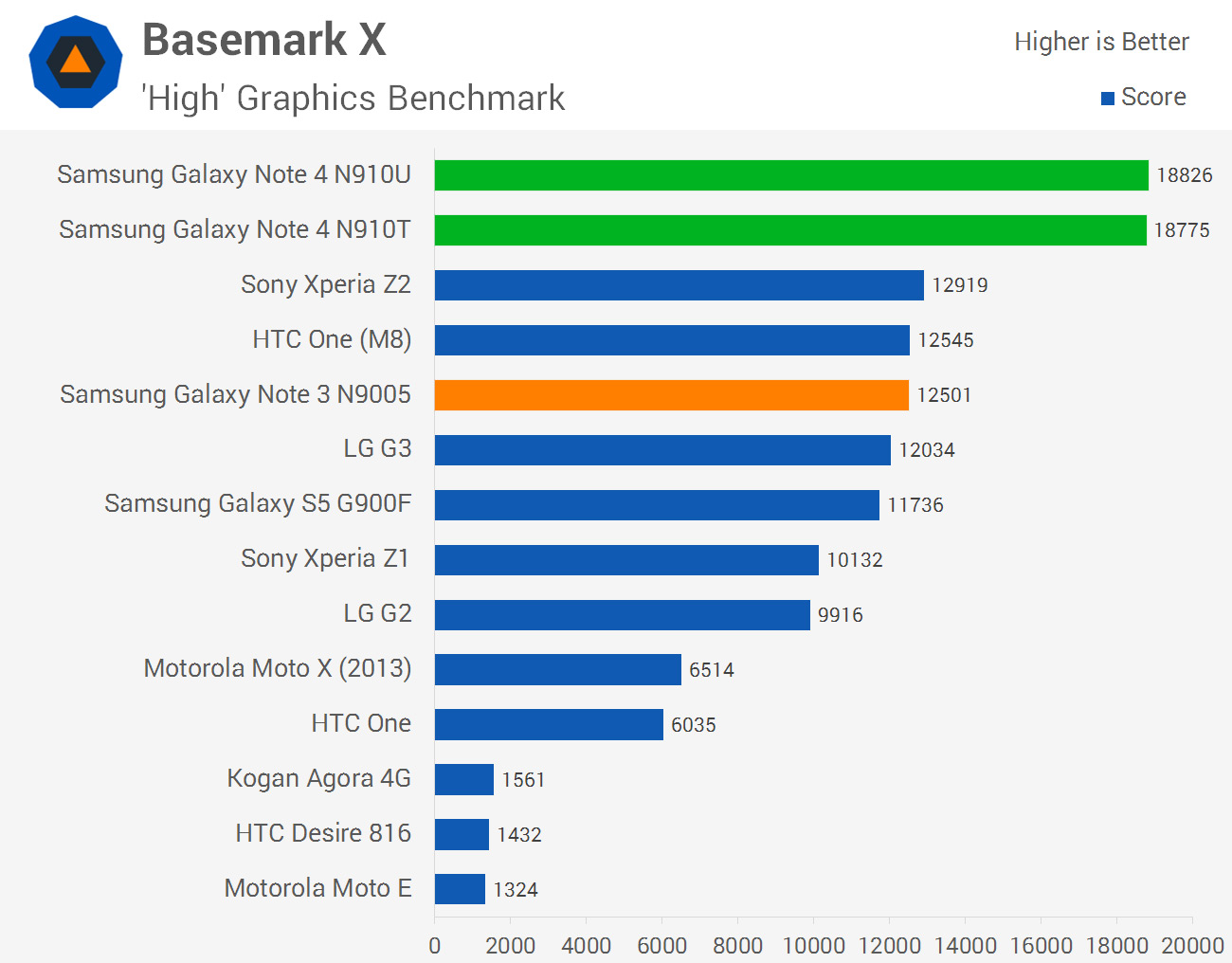Exynos & Snapdragon Performance
For this review, thanks to the assistance from fellow editor Shawn, I've managed to compile benchmarks for both the Snapdragon 805 model and the Exynos 5433 model. Personally I've been using the Exynos variant, so my impressions of the phone are based on that handset, but it appears as though both handsets are quite evenly matched.
There are a large number of Galaxy Note 4 models on the market, larger than the number of SoCs Samsung has used, so the model numbers seen in the benchmarks that follow may not correspond to what you'll see in your country. However, the vast majority of the hardware between the Snapdragon variants and the Exynos variants is the same, so you should expect near identical performance.
The Exynos model we used is the SM-N910U, which is the model on sale in Asia. For the Snapdragon variant, Shawn benchmarked the SM-N910T, the T-Mobile model in the United States. These devices can easily be compared to the Galaxy Note 3 models: the SM-N900 for Exynos, and SM-N9005 for Snapdragon; and the Galaxy S5: G900H for Exynos and G900F for Snapdragon.






Across our CPU-heavy benchmarks, we get the first glimpse of how powerful both the Snapdragon 805 and Exynos 5433 are. Starting with the Snapdragon 805, we're seeing an average performance increase of 13% over the 2.5 GHz quad-core Snapdragon 801, which is slightly higher than the corresponding jump in clock speed between the chips. This corresponds well from the information available on the new Krait 450 CPU cores in the Snapdragon 805, which have been upgraded slightly from an architecture standpoint.
What gets really interesting is the Exynos 5433. Samsung absolutely aren't backing down when it comes to their home-grown silicon, boasting comparable CPU performance to Qualcomm's top-end chip. Admittedly this is achieved over eight cores working in tandem, but it gives you an idea of how powerful ARM's Cortex-A57 cores are compared to Qualcomm's high-end offering. At 1.9 GHz and paired with some Cortex-A53s, the Exynos 5433 model is, on average, 7% faster than the 2.7 GHz Snapdragon 805 in CPU-heavy tasks.
Compared to the last Exynos model I benchmarked, the Exynos 5 Octa 5422 found in the Galaxy S5 G900H, we can get a near like-for-like look at what performance improvements we're getting from ARM's new architecture. The Exynos 5422 has four Cortex-A15 CPU cores clocked at 1.9 GHz paired with four Cortex-A7s clocked at 1.3 GHz in a big.LITTLE environment. These clock speeds are identical to the Exynos 5433, but with new architecture we can expect better performance, even while running in 32-bit mode.
On average, the Exynos 5433 is 18% faster than the Exynos 5422 in CPU-loaded tasks. ARM expects a 20-30% performance improvement going from A15 to A57 CPU cores in 32-bit mode, so I'm pretty happy with what the results show. Keep in mind that these benchmarks will also be utilizing the A53 cores in the Exynos 5433, which might not see as large a performance gain over the A7s (and the results hint in this direction).




Graphics has, over the past few generations, been a weak point for Samsung's Exynos chips. I'm glad to say that this is no longer the case, with the Exynos 5433 bringing a significantly improved GPU to the table that holds its own with the Snapdragon 805, which itself has improved over past chips. The Snapdragon model holds just a 5% lead over the Exynos model on average, which is a massive improvement over the 67% lead the Snapdragon 801 had over the Exynos 5422.
In this respect, I can safely conclude that the GPUs in each Note 4 are on par. This is a significant win for Samsung's microprocessor division, and removes one of the main downsides to purchasing the Exynos variant of a Galaxy product.
While I'm on the topic of the Exynos 5433, its Mali-T760 GPU was a whopping 58% faster than the Mali-T628 in the Exynos 5422 in my testing. This indicates that, as I expected, Samsung is using the Mali-T760MP8 in the Exynos 5433, which is certainly a performance beast. The Mali-T628 in its configuration in the Galaxy S5 was really only suitable for flagship graphics on a 720p display, whereas the Mali-T760 is a true Quad HD GPU.
Gains aren't as drastic in the Snapdragon 805 model, but Qualcomm didn't need to advance as rapidly in this area, as they already had a strong graphics division. On average the Adreno 420 GPU in the Snapdragon 805 is 39% faster than the Adreno 330 in the Snapdragon 801: certainly nothing to sneeze at.
These two new GPUs do have to render to 1440p displays that feature 77% more pixels than previous-gen 1080p panels, and in this respect they're both well suited. You won't get quite as high frame rates in intense 3D applications as you would from a Snapdragon 801 rendering to a 1080p display, but these more powerful chips are still very capable of running flagship titles from the Play Store.


The Galaxy Note 4 slots in behind the LG G3 to take second spot in NAND performance. It's good to see Samsung especially addressing random read/write performance in the hardware upgrade coming from the Galaxy S5, which was a weak spot in past handsets.
One thing that should be noted is that Samsung has decided to drop the microUSB 3.0 port in favour of standard microUSB 2.0. This means that read/write speeds drop from 100/60 MB/s to 35/35 across USB, which slows down transfers. I imagine the regression in this area is for aesthetic reasons: microUSB 3.0 is a large and potentially awkward port (if you're trying to use a microUSB 2.0 cable), so it looks like Samsung may be waiting for the Type-C connector to become more widespread before switching back to high-speed USB.
Just on storage, the Galaxy Note 4 comes with 32 GB of internal NAND that can be expanded through the microSD card slot found beneath the rear cover. Can't complain with this setup, though I wouldn't say no to more internal storage.

I did notice throughout my benchmarking runs that the Galaxy Note 4 throttles its SoC to a pretty significant level after around five minutes of heavy CPU/GPU load. After the end of a 30 minute run the Note 4 had lost just under 50% of its peak performance, as you can see in the graph above. Note that these results are for the Exynos model; I'll have to examine the Snapdragon model in more detail later, although I suspect it throttles to a similar extent.
Also note that average peak performance is what we have listed in our benchmarks. That is, the benchmarks illustrate the performance you can expect when the SoC isn't being throttled.

